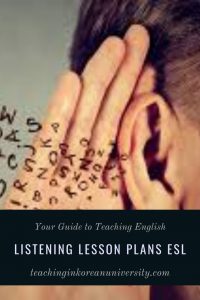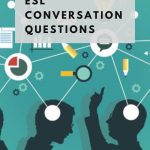If you’re serious about helping students improve their English listening skills, you’ve come to the right place! I’m going to share the steps that you need to know to plan a successful ESL listening lesson, including the steps to follow, game and activity recommendations and more. Keep on reading for everything you need to know about how to plan an ESL listening lesson.

ESL listening lesson plan
Let’s get into all the details you need to know about making a listening lesson plan ESL.
ESL Lesson Plan Template for Listening
I’m always surprised when I get reader questions or talk to people preparing for their upcoming job interviews that they don’t know how to make a basic lesson plan. But, it’s not so crazy and I actually had no system of any sort until I took the CELTA course a few years back.
After that course, I could recite the basic English listening lesson plan in my sleep!
The ESL listening lesson plan that I’m going to share with you today is modelled after that and it can provide you a solid foundation upon which to expand and adjust to suit the needs of your own class. There are five basic ESL lesson plan steps and one optional step for a class focused on listening that I’ll describe below.

Listening lesson plans
ESL Listening Plan Template
Let’s get to it. Here are the steps you can follow for a listening focused lesson plan.
Step #1: Set the Context
It’s really difficult for our students if we start the class off by getting straight into the task and we can seriously hinder their understanding of what they’re hearing. Think of a car on a cold, cold winter day (I’m from Canada!). First of all, all sensible people will plug their car in overnight in order to keep a bit of current running through the engine. Then, you put on your cold-weather gear for a little sprint out to the car and cross your fingers, hoping it’ll start.
Once it does, you go back into the house for a few minutes to give it some time to get the juices flowing and ready to go. If you neglect warming up your car, it may start but you’ll cause more wear and tear than if you gave it a few minutes to get going which is going to cost you in the long-run.
- Amazon Kindle Edition
- Bolen, Jackie (Author)
- English (Publication Language)
- 148 Pages - 03/09/2016 (Publication Date)
Ease Students into the Lesson with a Warm-Up
What I’m saying is that you need to help your students ease into the lesson by letting them get used to speaking English again. They also come into your classes with plenty of prior knowledge so it can be really useful if you take advantage of this so that later on in the lesson, students can connect the old with the new.
During one of my CELTA lessons, I was given a listening exercise dealing with medical dilemmas. I started off the class by asking students to talk with their partners for a couple of minutes about any medical dilemmas that they’ve seen or heard in the news the past few years.
Don’t forget to set the context at the beginning of your listening lesson. This is a key part of a Celta lesson plan template!

ESL listening lesson plan
Step #2: Pre-Listening Task
In the pre-listening task, you move from the more general of step #1 into the more specific as you now begin to focus on the actual listening exercise that your students are going to do. I often like to do prediction exercises where I reveal a little bit of information and then students have to make a guess about something. Then, in the next step they’ll have to listen to see if their guess was correct. It’s the perfect way to give your students a reason to listen.
An Example of a Task for a Listening Lesson Plan ESL
However, in the case of this medical dilemma lesson, the vocabulary was quite difficult. I was pretty sure that most of the students in the class wouldn’t be familiar with a lot of it. I gave the students a little worksheet to do with their partner to help familiarize themselves with the key words and then I asked some “CCQ’s” (concept checking questions) in order to make sure they really understood the words.
Step #3: Gist Listening Task
Students will listen to the passage twice. The first time is to get the big picture of what’s going on. The second listening is to get the finer details. If they get everything the first time, it’s too easy. If they need more than two times, it’s too difficult.
You should always give your students a reason to listen or read something so be sure to set a task. But, make it pretty easy such as a few True/False questions dealing with the big picture stuff, or they can see if their prediction from the previous stage was true.
Students compare answers and then you can quickly check. But, don’t get into the nitty-gritty details at this stage-that come’s next.
Step #4: Main Listening
In this stage, the students will listen a second time to the passage. Give them a task such as short answer or fill-in-the-blanks questions. They can be a bit trickier and focused on some of the nuances at this point. It’s a good test to see if the students actually understood the listening passage.
Have students again compare answers with a partner. Then you can check answers as a class. You can go into the finer details if necessary.
Step #5: Post-Listening Activities
I usually like to have students give their opinion about something that they heard in the listening.
For the medical dilemma one, the woman in the story wanted the doctor to help her commit suicide but it was illegal in her country. The question was whether or not doctors should be able to help patients do this.
Worksheets of some kind are another option, particularly if the class is more focused on grammar, vocabulary or writing as opposed to speaking.
You may also want to do some pronunciation activities based on the listening passage. You know what your students need to work on this area, so if they’re quite weak at this, then use this time to help them improve their skills.
Or, you could use this time to focus on some specific grammar of vocabulary from the listening passage. For example, Phrasal Verbs ESL.
What are Some Examples of Listening Activities?
- Amazon Kindle Edition
- Bolen, Jackie (Author)
- English (Publication Language)
- 85 Pages - 02/02/2020 (Publication Date)
That’s a great question and we’re happy that you asked! There are a number of listening games and activities that you might consider doing with your students. Some of the best ones can be found in this book: ESL Listening Activities for Teenagers and Adults that you can find over on Amazon.
There are dozens of student-centred, engaging activities that focus on a variety of listening sub-skills. The good news is that you can get the book in both digital and print formats. Take a copy with you to your favourite coffee shop for some lesson planning on the go, or keep a copy on the bookshelf in your office.
It really is that easy to have English listening classes! Check out the book for yourself, but only if you want a serious dose of ESL teaching awesome in your life:
(Optional) Step #6: Speaking Task
I often like to throw in a speaking task at the end of a listening or reading lesson because it can lighten up the mood a little bitt. Additionally, lots of speaking is often what students expect in our classes!
For the previous example, I had students switch partners and then I gave them a new medical dilemma. They had to assign for/against roles and then have a mini 5-minute debate. They switched partners again and this time changed roles.
(Optional) Step #7: Task-Based Learning Project
If you have a 3-4 hour class like I often did while teaching in Korean universities, you have a lot of time! At the end of a listening lesson like I just described, I’d often organize some sort of task based learning project based on the topic of the day.
Some task-based learning examples include the following:
- Preparing a speech
- Making a video
- Watching a video for inspiration for another activity
- Interviewing people
- Information gap activities
- Making a survey and then talking with classmates about it
- Problem-solving
- Matching or sorting
The sky really is the limit for what you can at this point in the lesson so feel free to get creative! However, it’s important to relate it back to the beginning of the listening part of the lesson so it’s not too disjointed. Think similar topics and you’ll be fine.
How Often Should I Play the Listening Passage?
As an English teacher, an excellent question is how often you should play the listening passage for the students. A good rule of thumb is twice. If you only have to play it once and the students understand everything easily, the level is too low for them.
However, if you have to play it 3+ times before they understand the basics, then it’s too difficult. If you have a say over it, it’s important to choose ones at an appropriate level for your students. There are a wealth of resources on the Internet, so this should be entirely possible.
The first time that the students listen, they should be able to pick up the big picture about what it’s about. The second time, students should be able to understand it in more detail and be able to answer some pretty specific questions about it.
Keep this in mind when choosing listening dialogues or passages for your students. They should have to work hard to understand, but not too hard!
- Amazon Kindle Edition
- Bolen, Jackie (Author)
- English (Publication Language)
- 278 Pages - 07/12/2020 (Publication Date)
The Listening Passages are too Difficult: What can I do?
It can sometimes be the case that you have to use a textbook that is too difficult for the students. You can often make the speaking, reading and writing sections work for you by simply adapting them to suit your needs and picking and choosing. However, listening is much harder to do because you can’t change it on the fly, and it also happens in real time.
If you can’t just skip over it, what can you do? I have a number of tips and tricks for how to deal with this kind of situation:
Too Difficult Listening Exercises: What Can I Do?
Where Can I Find Good ESL Listening Passages?
There are a number of places online where you can find listening passages for your students. Here are just a few of them:
- In the textbook you’re using for that class. This is often the best source because the grammar and vocabulary are totally relevant to what you’re teaching. Quick tip: the audio files can often be found online—look at the book publisher’s website for them.
- From Breaking News English. I LOVE this website because it has a wealth of materials at different levels, and a massive array of interesting topics. You’re sure to find something that will work.
- English Central. YouTube works well, but it can sometimes be difficult to not waste a ton of time looking for videos that are at the appropriate level. English Central is specifically for English learners.
- Business English Pod. If you teach business English, this site should be one of your go-to resources. The listening exercises are excellent.
What about Listening With Mixed Level Classes?
That’s a great question and we’re happy that you asked! It can be challenging for a teacher of mixed level English classes to do listening.
The more advanced level students will get it on the first run through quite easily. The average students will take the second time to understand most of it. And the weaker ones will still struggle, even if you play it 4-5 times.
What’s the solution? Unfortunately, there isn’t a really good one. Something you can do is play it 2-3 times, and then make the transcript available. This will allow the weaker students to have something to refer to so they can at least complete the comprehension questions. The major downside is that it becomes a reading lesson instead of a listening one. The better students will just complete the questions from memory most likely though.
Another idea is to just accept that the weakest students will probably struggle no matter what you do, and the higher-level ones will be bored no matter what you do. Don’t worry too much about it, especially with the weaker ones. After all, their poor English ability compared to their peers has a million and one things to do with them and not a single one related to you!
Looking for other kinds of ESL Lesson Plans?
If you’re looking for some ESL lesson plan templates for skills besides listening, then you’ll want to check out the following. They are ideal for planning a speaking or reading ESL lesson.
ESL Speaking Lesson Plan Template
ESL Reading Lesson Plan Template
Where Can I find ESL Listening Lesson Plans?
Okay, so you are short of time and don’t want to plan your own listening lesson plan ESL. I get that. Seriously. We’ve all been there when you just need something in a hurry in the few minutes before class.
So, what are my go-to sources for ESL listening lessons? Here are some of the top recommendations:
ESL Listening Lesson FAQs
There are a number of common questions that people have about making a listening lesson plan ESL. Here are the answers to some of the most popular ones.
How do You Prepare Students for Listening Lessons?
Here is the basic structure you’ll want to follow in order to prepare your students for listening lessons:
- Before listening introduce the topic and set the context.
- During listening, be specific about what students should listen for.
- After listening, finish with an activity to extend the topic.

Preparing for ESL listening lessons
How Can ESL Students Improve their Listening Skills?
Here are a few quick tips for how your ESL students can improve their listening skills:
- Listen with a purpose
- Encourage students to become active listeners instead of passive ones
- Give clear instructions
- Use a variety of listening passages, both native and non-native speakers
- Bring real life into the classroom
- Practice listening a lot
- Have students compare answers
- Listen more than once
- Don’t forget to set the context first

Improve ESL listening ability
What are the 6 Steps of the Listening Process?
There are 6 steps in the listening process. They are:
- Hearing
- Attending
- Understanding
- Remembering
- Evaluating
- Responding
Although they occur in sequence, it happens so quickly that there is usually little awareness of which stage is happening at that precise moment in time.
Like this ESL Listening Lesson Plan? Then You’ll Love this Book
- Amazon Kindle Edition
- Bolen, Jackie (Author)
- English (Publication Language)
- 148 Pages - 03/09/2016 (Publication Date)
Then you’re going to love this book, 101 ESL Activities: For Teenagers and Adults. There are ESL games and activities that cover all kinds of things-icebreakers/warm-ups, speaking, listening, reading, writing, grammar, and 4-skills activities. It’s the book that belongs on every English teacher’s personal bookshelf. Or, keep a copy on your phone for lesson planning at your favourite coffee shop.
Each activity starts off with a brief overview of the activity so that you can, at a glance whether or not it’s right for your class. After that, it gets into the detailed, step-by-step instructions, starting with the prep to do before class and then finishing with any follow-up activities for when it’s done.
Also don’t forget to read the important teaching tips. They’ll give you some advice for making the activity as awesome as possible, and also some of the most common mistakes to avoid.
Available in Both Digital and Print Formats
You can get the book in both digital and print formats. The cheaper electronic version can be read on any smartphone, tablet, Kindle reading, Mac, or PC. You just have to download the free Kindle reading app.
Keep a copy on the bookshelf in your office as a handy reference guide for making your lesson plans. Or, take a copy on your phone or tablet to your favourite coffee shop for lesson planning on the go.
Check out the book for yourself on Amazon today and get ready for some ESL lesson planning awesome!
What are your thoughts about this ESL Lesson Plan Template?
Leave a comment below and let us know the steps you follow when teaching ESL listening. Do you have any tips or tricks for doing it well? We’d love to hear from you.
Also be sure to give this article a share on Facebook, Pinterest, or Twitter. It’ll help other busy teachers, like yourself find this useful resource.
p.s. You may want to consider doing a listening passage for a holiday-themed lesson. More details about that here: ESL Halloween Games and Activities.

Listening lesson plan template ESL
Last update on 2022-06-17 / Affiliate links / Images from Amazon Product Advertising API








